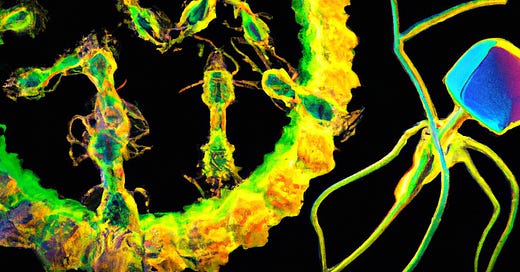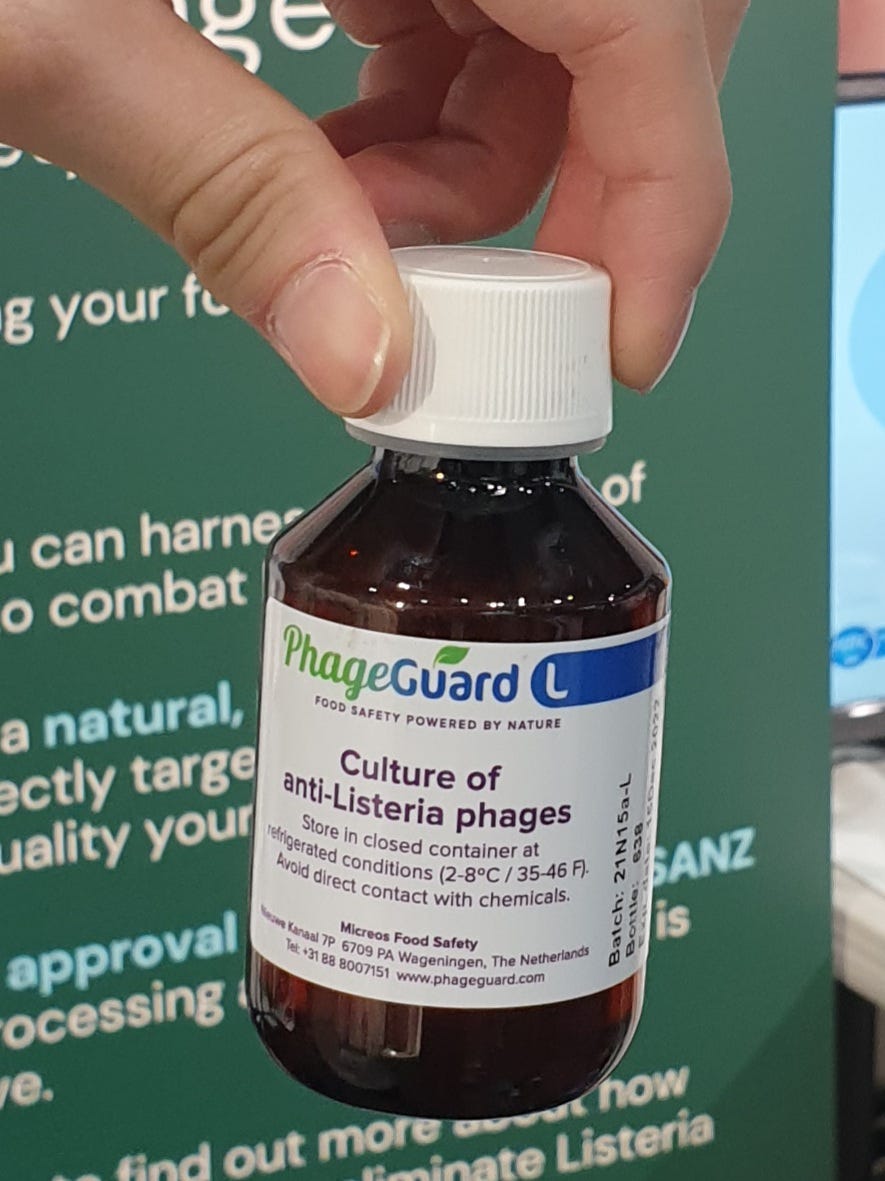100 | Teeny Blobs of Biological Code that Have the Power to Change the World
Plus sesame allergens, regenerative ag and cancer-causing properties in red meat
This is The Rotten Apple, an inside view of food integrity for professionals, policy-makers and purveyors. Subscribe for weekly insights, latest news and emerging trends in food safety, food authenticity and sustainable supply chains.
Save the date: Food Safety Culture Live Training 17/18 August
Bacteriophages - weird little viruses that changed the world
Food safety news and free (good) resources
Quick bites: sesame allergens, regenerative ag and cancer properties of red meat
Food fraud news and incidents
Happy Monday,
Welcome to the ONE-HUNDREDTH issue of this newsletter. If you’re new here, thank you for joining me. And a massive 👏 thank you 👏 to our new paying subscribers, your support makes this newsletter possible. Couldn’t do it without you!
The big story this week is about mysterious alien-like mini-viruses, inspired by meeting a company that uses them for food safety purposes. Also this week, sesame allergens, regenerative agriculture and red meat science.
As always there’s a roundup of this week’s food safety news (click the link in the email for access), plus food fraud news and a human-friendly 🎧 audio version, for paying subscribers.
Have a marvellous week,
Karen
P.S. If you love this newsletter, please share it. Sharing helps us grow.
Live Training Event
Our next live training event is on the 17th or 18th August (Thursday/Friday) - depends on your timezone. I’ll be presenting a curated selection of food safety culture resources for building, measuring and documenting a robust culture (and acing your next audit!).
Everyone is welcome, and recordings are available for paying subscribers.
🍏 Details here: Food Safety Culture Training - 17th/18th August 2023 🍏
Bacteriophages
Teeny blobs of biological code that have the power to change the world
What if there was a weapon of mass destruction specifically targeted to just one type of bacteria… some sort of biological weapon that would knock down a pathogen like Listeria without hurting anything around it?
Sounds powerful, right?
Bacteriophages have that power. They are blobs of genetic code - DNA or RNA - surrounded by a protein coat (‘capsid’); viruses that only attack bacteria, leaving other lifeforms alone. (Okay pedants, they also attack archaea which are bacteria-like organisms). Their name, bacteriophage, means “bacteria eater”.
They are tiny.
As viruses, bacteriophages do the kinds of things other viruses do… they infect cells and cause havoc inside, taking over the host cell’s replication machinery and making copies of themselves, eventually causing the cell to burst open and release the replicants.
Typical virus stuff.
They also do special phagey stuff, like incorporating their own genetic material into the host’s cell* so that it is replicated during normal bacterial reproduction. In this process, called the lysogenic cycle, the bacteriophage’s genetic material either becomes incorporated into the bacteria’s chromosome or forms its own circular replicon in the cell.

Bacteriophages don’t just insert themselves into other creature’s genes, they can also transfer genetic material between different strains and species of bacteria. That is, they transfer genetic material that is not theirs. The process is known as transduction and it occurs when DNA from an infected bacterial cell gets packaged inside newly formed viral particles.
This process plays an important role in the transfer of both antimicrobial resistance genes and virulence genes between and within bacterial species.

Powering up bacteria against antibiotics
Antimicrobial resistance (AMR) is considered one of the greatest challenges facing modern medicine and modern agriculture. When it comes to AMR, bacteriophages have a role to play as both friend and foe.
As a foe, they are thought to contribute to the spread of antimicrobial resistance in bacterial communities. As a ‘friend’ they may prove to be powerful replacements for antibiotics in agriculture and human medicine.
Antimicrobial-resistant infections kill more than 4.95 million people each year and are in the top ten global public health threats facing humanity.
Researchers have observed the bacteriophage-induced transfer of antimicrobial resistance genes in both E. coli and Salmonella typhimurium cells in the lab, and hypothesise that genes encoding for antimicrobial resistance in hospital effluent and urban sewage could be transferred to bacteria in food supply chains such as fisheries, food-producing animals and slaughterhouses (source).
Virulence genes are also thought to be transferred by bacteriophages, including between strains of the important foodborne pathogen Staphylococcus aureus (source).
As a ‘friend’ bacteriophages have been used to treat antimicrobial-resistant infections in humans. Phage therapy - in which a cocktail of bacteriophages or a custom-made phage culture - is administered to patients with serious and otherwise incurable antibiotic-resistant infections has proven to be successful at treating persistent urinary tract infections, bone infections and biofilm-affected implants. However, randomised clinical trials have not yet provided conclusive evidence to support its widespread use (source).
Bacteriophages in food pathogen control
Dozens of studies have investigated the effectiveness of applying phages to foods and food contact surfaces to reduce pathogens. Combinations included Salmonella on romaine lettuce, Salmonella on cantaloupe, Listeria monocytogenes on cut spinach, E. coli on alfalfa sprouts and shiga-toxin-producing E. coli on meats, with varying results (find a list, plus results, summarised here).
Listeria-specific phages have been commercialised as a pathogen control technology in recent years. For example, the makers of PhageGuard claim their product has an advantage over chemical sanitisers when it comes to destroying biofilms of Listeria monocytogenes. They claim it can be applied to food contact surfaces like conveyor belts during processing without imparting any off-flavours to the food.
The phage control solution is purchased as a highly concentrated product that is diluted with dechlorinated water to 1% - 5% before use. The solution is sprayed onto food contact surfaces or persistent biofilms and can achieve 2 - 3 log reductions in a contact time of between one and three hours, according to the company’s marketing material.
At least one large food company is using the product to treat food contact surfaces in Australia, according to a representative of the company I spoke to at Australia’s FoodPro last month.
In short: 🍏 Bacteriophages are viruses that attack bacterial cells 🍏 They can persist in host cells without destroying them 🍏 This allows them to transfer their own genetic material and the genetic material of their hosts between cells 🍏 Such transduction can help antimicrobial resistance spread within or between bacterial species 🍏 It may also play a role in the transfer of virulence between bacterial pathogens 🍏 Bacteriophages have been used to control food pathogens on foods and food contact surfaces 🍏
Main Source (secondary sources are referenced using in-text hyperlinks): Colavecchio, A., Cadieux, B., Lo, A. and Goodridge, L.D. (2017). Bacteriophages Contribute to the Spread of Antibiotic Resistance Genes among Foodborne Pathogens of the Enterobacteriaceae Family – A Review. Frontiers in Microbiology, 8. doi:https://doi.org/10.3389/fmicb.2017.01108.
*Certain mammal viruses can do this too, including the AIDs virus and the Herpes Simplex virus (source).
Food Safety News and Resources
7th August | Food Safety News and Free Resources | ⚠ Surprise! The rocks-in-cookies-company is now recalling falafels because they (also) contain rocks (USA) ⚠ Trader Joe’s has recalled falafel in 35 states because they might contain rocks. Last week the same company recalled cookies for the same reason. Also last week, the same company’s aptly named
Quick Bites
Sesame allergen update
This is so silly. Some USA food companies started deliberately adding sesame flour to breads, buns and cakes earlier this year in response to new rules that require sesame allergens to be disclosed on labels.
According to one commentator, the food manufacturers say “they can’t sufficiently clean their equipment to guarantee it is free of sesame… and under federal labeling rules, they can’t state that their products contain sesame unless the items actually contain it — so they’re adding sesame and labeling it.” (Source)
The practice is very bad for allergic consumers, who were taken by surprise when it began in January. A consumer group soon petitioned the US Food and Drug Administration (FDA), asking them to…
tell food manufacturers they cannot meet their allergen cross-contamination obligations by deliberately adding allergens; and
clarify the FDA guidance on food labelling as they relate to “May contain” statements.
The FDA said no. They did, however, provide new draft guidance that confirms that “Contains” statements can’t be used for allergens that are not actual ingredients of the food. Sigh.
Read the FDA’s petition response here.
More food with less farming - the regenerative ag debate
The wonderful Tamar Haspel has responded to George Monbiot’s book Regenesis in The Washington Post. Tamar’s article provides an elegant TLDR (too long, didn’t read) summary of Regenesis.
Haspel and Monbiot agree that land use is an important contributor to emissions from food systems. Yup. BUT. Humanity is still bringing old carbon (fossil fuels) to the earth’s surface. While we keep doing this, discussions about re-wilding beef farms are akin to talking about deckchairs on the Titanic.
Gross emissions from food systems are high (between one-quarter and one-third of all greenhouse gas emissions), but net emissions are much lower because growing food captures carbon.
The regenerative ag debate is good, but let’s pay more attention to the iceberg than the deck chairs.
Sources: 🍏 Tamar Haspel in the Washington Post 🍏 Me on net carbon from food systems 🍏
More like this: Check out a thought-provoking but slightly weird debate between Monbiot and environmentalist Alan Savory on why we need livestock farming to save the planet, using this video by a soil-climate YouTuber for an explanation of Savory’s hard-to-follow arguments.
How red meat causes cancer?
The science is pretty solid on links between the consumption of red meat and cancer in humans, but the mechanism has been a mystery. A new study may have answers. It suggests that meat cooked at high temperatures could damage the DNA in the food, leading to increased cancer risk in those consuming it.
Sources: https://doi.org/10.1021/acscentsci.2c01247 and https://www.eurekalert.org/news-releases/992430
What you missed in last week’s email
Root cause analysis for hallucinogenic spinach, plus the guy who purchased 300 packs of it
A food fraud win for turmeric
Food fraud news and incidents
Meat lasers (just for fun)
Below for paying subscribers: Food fraud news and incident reports, plus an 🎧 audio version of this issue 🎧
📌 Food Fraud News 📌
Fake tuna scandal
The ‘fake’ Subway tuna (non)scandal is over. A lawsuit was lodged against Subway in 2021 after a plaintiff had ‘tuna’ filling from a Subway sandwich tested and the laboratory found no tuna DNA in the substance. Another set of tests at a different lab





